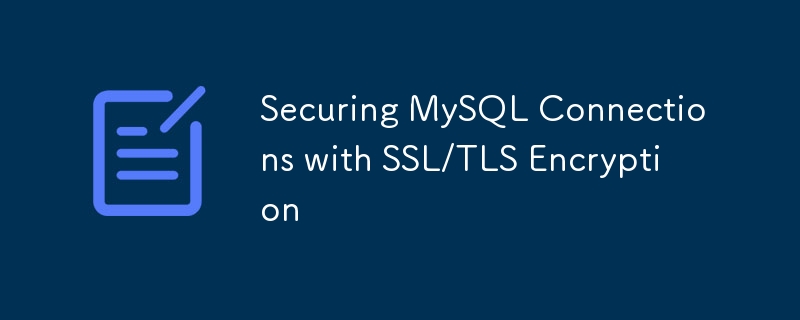Securing MySQL Connections with SSL/TLS Encryption
Jul 21, 2025 am 02:08 AMWhy do I need SSL/TLS to encrypt MySQL connections? Because unencrypted connections can cause sensitive data to be intercepted, enabling SSL/TLS prevents man-in-the-middle attacks and meets compliance requirements; 2. How to configure SSL/TLS for MySQL? You need to generate a certificate and a private key, modify the configuration file to specify the ssl-ca, ssl-cert and ssl-key paths and restart the service; 3. How to force SSL when the client connects? Implemented by specifying REQUIRE SSL or REQUIRE X509 when creating a user; 4. Details that are easily overlooked in SSL configuration include certificate path permissions, certificate expiration issues, and client configuration requirements.

The connection security issue of MySQL is becoming increasingly important in modern applications, especially during data transmission. Using SSL/TLS encryption is an effective means to prevent man-in-the-middle attacks. If you are managing a MySQL service and want to ensure that communication between the client and the server is secure, enabling SSL/TLS is a necessary step.

1. Why do I need SSL/TLS to encrypt MySQL connection?
Unencrypted MySQL connection means that username, password, query statements, and returned data can all be intercepted by attackers on the network. This risk is higher especially in public or shared network environments. After SSL/TLS is enabled, all communications will be encrypted, and even if the data is intercepted, it cannot be easily interpreted.
In addition, some compliance requirements (such as finance, medical and other industries) clearly require that data transmission must be encrypted. Therefore, enabling SSL/TLS is not only a security measure, but may also be a mandatory requirement.

2. How to configure SSL/TLS for MySQL?
MySQL supports using OpenSSL to enable SSL/TLS encrypted connections. You need to prepare the server-side certificate and private key and enable SSL support in the configuration file.
The configuration steps are as follows:
- Generate certificates and private keys : You can use the OpenSSL tool to generate a self-signed certificate for testing, or use a formal CA certificate for production environments.
- Modify the MySQL configuration file (my.cnf or my.ini) :
[mysqld] ssl-ca=/path/to/ca.pem ssl-cert=/path/to/server-cert.pem ssl-key=/path/to/server-key.pem
- Restart the MySQL service to make the configuration take effect.
- Verify that it is enabled successfully : After connecting through the client, execute
SHOW STATUS LIKE 'Ssl_cipher';. If a non-null value is returned, SSL is enabled.
3. How to force SSL when client connection?
To ensure that all connections use encryption, you can specify REQUIRE SSL when creating a user, for example:

GRANT USAGE ON *.* TO 'secure_user'@'%' REQUIRE SSL;
This way, any client that attempts to connect without SSL will be denied access. You can also use REQUIRE X509 to further require the client to provide a valid certificate.
FAQ:
- The client connection failed, prompting SSL-related errors: It may be that the certificate path is configured incorrectly, or the client does not load the CA certificate correctly.
- Some client tools do not verify server certificates by default: it is recommended to enable verification for enhanced security.
4. Details that are easily overlooked in SSL configuration
- Certificate path permissions : The MySQL service needs to have read permissions on the certificate file, otherwise an error will be reported when starting, but there will be no obvious prompt that it is a permission problem.
- Certificate expiration issue : Self-signed certificates are usually valid for a short period of time. Remember to update them regularly, otherwise it will cause connection interruption.
- Client configuration : Some clients (such as MySQL Workbench, command line clients) need to manually specify
--ssl-mode=REQUIREDor load a CA certificate to establish an encrypted connection.
Basically that's it. Configuring SSL/TLS does not seem complicated, but many problems lie in details, such as paths, permissions, certificate formats, etc. As long as you take it step by step, it can still be enabled smoothly.
The above is the detailed content of Securing MySQL Connections with SSL/TLS Encryption. For more information, please follow other related articles on the PHP Chinese website!

Hot AI Tools

Undress AI Tool
Undress images for free

Undresser.AI Undress
AI-powered app for creating realistic nude photos

AI Clothes Remover
Online AI tool for removing clothes from photos.

Clothoff.io
AI clothes remover

Video Face Swap
Swap faces in any video effortlessly with our completely free AI face swap tool!

Hot Article

Hot Tools

Notepad++7.3.1
Easy-to-use and free code editor

SublimeText3 Chinese version
Chinese version, very easy to use

Zend Studio 13.0.1
Powerful PHP integrated development environment

Dreamweaver CS6
Visual web development tools

SublimeText3 Mac version
God-level code editing software (SublimeText3)

Hot Topics
 Choosing appropriate data types for columns in MySQL tables
Jul 15, 2025 am 02:25 AM
Choosing appropriate data types for columns in MySQL tables
Jul 15, 2025 am 02:25 AM
WhensettingupMySQLtables,choosingtherightdatatypesiscrucialforefficiencyandscalability.1)Understandthedataeachcolumnwillstore—numbers,text,dates,orflags—andchooseaccordingly.2)UseCHARforfixed-lengthdatalikecountrycodesandVARCHARforvariable-lengthdata
 mysql common table expression (cte) example
Jul 14, 2025 am 02:28 AM
mysql common table expression (cte) example
Jul 14, 2025 am 02:28 AM
CTE is a temporary result set in MySQL used to simplify complex queries. It can be referenced multiple times in the current query, improving code readability and maintenance. For example, when looking for the latest orders for each user in the orders table, you can first obtain the latest order date for each user through the CTE, and then associate it with the original table to obtain the complete record. Compared with subqueries, the CTE structure is clearer and the logic is easier to debug. Usage tips include explicit alias, concatenating multiple CTEs, and processing tree data with recursive CTEs. Mastering CTE can make SQL more elegant and efficient.
 How to use PHP to develop a Q&A community platform Detailed explanation of PHP interactive community monetization model
Jul 23, 2025 pm 07:21 PM
How to use PHP to develop a Q&A community platform Detailed explanation of PHP interactive community monetization model
Jul 23, 2025 pm 07:21 PM
1. The first choice for the Laravel MySQL Vue/React combination in the PHP development question and answer community is the first choice for Laravel MySQL Vue/React combination, due to its maturity in the ecosystem and high development efficiency; 2. High performance requires dependence on cache (Redis), database optimization, CDN and asynchronous queues; 3. Security must be done with input filtering, CSRF protection, HTTPS, password encryption and permission control; 4. Money optional advertising, member subscription, rewards, commissions, knowledge payment and other models, the core is to match community tone and user needs.
 Setting up semi-synchronous replication in MySQL
Jul 15, 2025 am 02:35 AM
Setting up semi-synchronous replication in MySQL
Jul 15, 2025 am 02:35 AM
The steps for setting MySQL semi-synchronous replication are as follows: 1. Confirm the version supports and load the plug-in; 2. Turn on and enable semi-synchronous mode; 3. Check the status and operation status; 4. Pay attention to timeout settings, multi-slave library configuration and master-slave switching processing. It is necessary to ensure that MySQL 5.5 and above versions are installed, rpl_semi_sync_master and rpl_semi_sync_slave plugins, enable corresponding parameters in the master and slave library, and configure automatic loading in my.cnf, restart the service after the settings are completed, check the status through SHOWSTATUS, reasonably adjust the timeout time and monitor the plug-in operation.
 Automating MySQL Deployments with Infrastructure as Code
Jul 20, 2025 am 01:49 AM
Automating MySQL Deployments with Infrastructure as Code
Jul 20, 2025 am 01:49 AM
To achieve MySQL deployment automation, the key is to use Terraform to define resources, Ansible management configuration, Git for version control, and strengthen security and permission management. 1. Use Terraform to define MySQL instances, such as the version, type, access control and other resource attributes of AWSRDS; 2. Use AnsiblePlaybook to realize detailed configurations such as database user creation, permission settings, etc.; 3. All configuration files are included in Git management, support change tracking and collaborative development; 4. Avoid hard-coded sensitive information, use Vault or AnsibleVault to manage passwords, and set access control and minimum permission principles.
 mysql incorrect string value for column
Jul 15, 2025 am 02:40 AM
mysql incorrect string value for column
Jul 15, 2025 am 02:40 AM
MySQL error "incorrectstringvalueforcolumn" is usually because the field character set does not support four-byte characters such as emoji. 1. Cause of error: MySQL's utf8 character set only supports three-byte characters and cannot store four-byte emoji; 2. Solution: Change the database, table, fields and connections to utf8mb4 character set; 3. Also check whether the configuration files, temporary tables, application layer encoding and client drivers all support utf8mb4; 4. Alternative solution: If you do not need to support four-byte characters, you can filter special characters such as emoji at the application layer.
 How to use PHP to develop product recommendation module PHP recommendation algorithm and user behavior analysis
Jul 23, 2025 pm 07:00 PM
How to use PHP to develop product recommendation module PHP recommendation algorithm and user behavior analysis
Jul 23, 2025 pm 07:00 PM
To collect user behavior data, you need to record browsing, search, purchase and other information into the database through PHP, and clean and analyze it to explore interest preferences; 2. The selection of recommendation algorithms should be determined based on data characteristics: based on content, collaborative filtering, rules or mixed recommendations; 3. Collaborative filtering can be implemented in PHP to calculate user cosine similarity, select K nearest neighbors, weighted prediction scores and recommend high-scoring products; 4. Performance evaluation uses accuracy, recall, F1 value and CTR, conversion rate and verify the effect through A/B tests; 5. Cold start problems can be alleviated through product attributes, user registration information, popular recommendations and expert evaluations; 6. Performance optimization methods include cached recommendation results, asynchronous processing, distributed computing and SQL query optimization, thereby improving recommendation efficiency and user experience.
 how to connect excel to mysql database
Jul 16, 2025 am 02:52 AM
how to connect excel to mysql database
Jul 16, 2025 am 02:52 AM
There are three ways to connect Excel to MySQL database: 1. Use PowerQuery: After installing the MySQLODBC driver, establish connections and import data through Excel's built-in PowerQuery function, and support timed refresh; 2. Use MySQLforExcel plug-in: The official plug-in provides a friendly interface, supports two-way synchronization and table import back to MySQL, and pay attention to version compatibility; 3. Use VBA ADO programming: suitable for advanced users, and achieve flexible connections and queries by writing macro code. Choose the appropriate method according to your needs and technical level. PowerQuery or MySQLforExcel is recommended for daily use, and VBA is better for automated processing.






